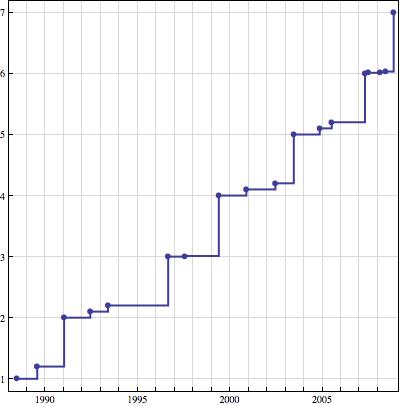The next Mathematica
To me, an intermediate and somewhat casual Mathematica user, the news that Mathematica 7 had been released was a surprise. Surprising to me because Mathematica usually goes much longer between major-digit releases; I would have anticipated this to be Version 6.1. For fun, I’ve plotted the history of Mathematica versions1 :

Release dates of versions of Mathematica
Mathematica 6 was a substantial upgrade: the graphics system was completely overhauled, the curated data, that I’ve used as the basis for some posts here, was added, and the ability for dynamic interactivity was added with Manipulate and Dynamic.
I am not, of course, a major Mathematica user. In fact, although I’m a physicist, I haven’t made tremendously much use of Mathematica for my professional work. This is partly because I tend to deal with relatively small data sets, for which a GUI-based data analysis tool is usually easier to work with than the command-line Mathematica. And I’d consider myself an advanced user of Pro Fit, the data analysis tool that’s made all the graphs for all the work I’ve done since about 1998.
In fact, my Mathematica license is my own personal one. As a graduate student, I bought the Student version of Mathematica, which they allow you to upgrade to a full professional license for only a few hundred dollars, compared to the $2500 list price of a new professional license.
Wolfram really wants its users to buy Premier Service, a several hundred dollars per year service which entitles you to all upgrades, major and minor. If you don’t buy premier service, then you need to pay for all upgrades, even the N.M.X to N.M.X+1 minor bug-fixing upgrades. And without premier service, you’re not even supposed to install Mathematica on more than one computer. Draconian and greedy, if you ask me, but they can do that, because they’re Wolfram. And for tech-heavy firms that make heavy use of Mathematica and get millions of dollars worth of value from whatever they compute in Mathematica, it makes sense. But it makes it very difficult to be a casual user.
And even though your existing copy can do everything it could the day you bought it, once the difference between your copy and the current release gets large enough, there is no longer an upgrade path. I think this is one of the motivations to release this as version 7 and not 6.1: I don’t recall the precise figure, but Wolfram generally offers an upgrade path only for jumps smaller than 1.5. If this is still the case,2 what this does is cut off anyone who hadn’t upgraded to version 6. Update: enough with the conspiracy theories! Wolfram clears up the upgrade policy in the comments.
In my case, with Version 6.0.1, I have a choice of paying $750, and getting a year of Premier Service, or paying $500 for just version 7.0.0 with no service. Out of my own pocket, ouch! But what makes it really enticing, for me, is that Mathematica now reads SHP files. These are the Geographic Information System data files, promulgated by ESRI, in which vector-valued geographic data is commonly exchanged. In particular, the DC Office of Planning makes an amazingly large collection of DC GIS data available in SHP format. The possibility for quantitative analysis of DC mapping data is very tantalizing.
Of course, Wolfram wouldn’t release a major number upgrade without hundreds of other new features. As of yet, there isn’t much substantial written about version 7. I did find some notes from a beta-tester and from a college math teacher. I’ll probably buy it, even though it would mean delaying other expensive toys that I want.
- most of the dates come from the Wolfram News Archive, some from the Mathematica scrapbook pages [
]
- I’ve asked Wolfram, but haven’t received a reply. [
]

3 comments
Hi
I’m the beta tester who’s notes you found. I should be getting my full copy of mathematica soon so if you have any questions or anything you’d like me to try out for you then feel free to ask.
I know we have some GIS users at my University and I’d like to put together a couple of quick Mma demos for them eventually but I have no idea what would get their attention since I know nothing about the subject. Any ideas would be gratefully received.
Cheers,
Mike
To clarify our upgrade policies: We have had a long standing policy of offering upgrades paths from at least the previous two feature releases (major or minor) and any number of maintenance releases. In that respect there is no advantage in naming it Mathematica 7 rather than 6.1. The naming is purely to reflect the large amount of new functionality.
Currently we are briefly providing upgrade paths back as far as 3.0 (released 1996).
If you transfer your license from a single machine license to a network license, you will be able to use Mathematica from any machine on your local network without the need to take Premier Service. I would however recommend Premier Service anyway.
@Michael– I’m even more a GIS hobbyist than a Mathematica hobbyist; in particular, I don’t have Arc(View|Editor|Info|GIS) so I have no basis for telling what might be easier in Mathematica than with a standard, professional GIS product. And Wolfram’s SHP import documentation is pretty sparse, so I can’t say how easy my ideas would be to realize. But with the DC GIS data, I’d like to do things like map walking distances to Metro stations or parks or grocery stores, using actual sidewalk routes, and compute proximity-based “scores” along the lines of walkscore.
@Jon–Thanks for the clarification; I’ve updated the post.
Leave a Comment